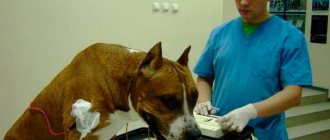Many people have dogs as pets. These are excellent watchmen, security guards, friends and companions. But all living beings are susceptible to various kinds of diseases, one of the most common is heart disease. It is difficult to determine this disease in dogs, but it is quite possible. In this article, we will introduce dog breeders to the skills of diagnosing heart disease in pets. But first, we suggest you understand the question of which side a dog’s heart is on. The animal, like most representatives of the fauna, has an organ on the left side. But everything is not so simple here, let's look at the issue in more detail.
Where is a dog's heart?
The dog's heart protrudes into both thoracic cavities (pleural), mostly from the third to sixth intercostal space on the left side. If you look at the chest of a dog standing upright, most of the organ will be located between the triceps muscles, almost in the middle.
To accurately determine which side your dog's heart is on, pay attention to the horizontal line that runs through the point of the shoulder joint. This line is located slightly above the valves of the heart muscle.
Studies applied to heart disease in cats and dogs
The first is a detailed anamnesis (survey) of the animal’s entire life and an anamnesis of the life of its parents. It is also necessary to pay attention to the breed of the animal and the climate in which it is kept. This is followed by examination and auscultation of the animal (a method of examining internal organs by listening).
X-ray of the chest in frontal and lateral projection
It is needed to assess the size of the heart and identify enlargements of one or another part of the heart.
Blood chemistry
When carrying it out, you need to pay attention to: - indicators of AST and ALT - these are two enzymes that are contained in myocardial cells and liver cells; when these cells are damaged, enzymes are released into the blood, where we can monitor their levels; — electrolytes; - Troponins I and T (if possible) are proteins found in skeletal muscle and cardiac muscle; when they are destroyed, the level in the blood can be monitored.
Sonographic examination
It is necessary to determine the size of the chambers and muscles of the heart, to assess the function and structure of the valves, to identify regurgitation (reverse reflux of blood), etc.
Electrocardiogram
An ECG will help identify disturbances in the rhythm and conduction of the heart, as well as a lot of indirect signs of disturbances in the functioning of the heart and its structure.
Blood smear for dirofilariasis
It may be needed for animals living in the southern part of the country. Heartworm is a parasitic disease that is carried by mosquitoes and spreads throughout the body through the bloodstream; Often adults live in the right atrium.
All these studies can be carried out in our clinic.
It is important to understand that the heart is a complex structure consisting of nerve nodes and fibers, muscles and valve apparatus. This is why such extensive diagnostics are required.
How to count your heartbeat and check your pulse
Knowing which side of your dog's heart is on, you can easily measure your heartbeat. Place your ear to your pet's chest so that the heart is lower. Or place your palm on the left side of the dog's chest, but not in front of the elbow, but behind it.
You can also check your pulse yourself; to do this, you need to lightly press on the artery, which is located on the inside of the thigh. Finding the artery is easy, pay attention to the area of the thigh where the leg meets the body - the pulsation is visually detected, this is the artery.
There are many areas in veterinary medicine where we lag behind conventional human medicine, and cardiology is one of them. It is in a dog owner's best interest to be able to recognize the symptoms of heart disease in dogs. Diagnosis at an early stage of the disease will allow you to start treatment with medications on time, improve your pet’s health and return his life to normal.
Basic information
Unlike people, most dogs, even with poor nutrition, will not suffer from heart disease. But dogs are predisposed to many defects that cause heart failure. This leads to stagnation in both circles of blood circulation, and it greatly affects the functioning of all organs.
Heart disease in dogs can go on without symptoms for quite a long time. As a rule, there will be no treatment, but even in this case, a pet, like a person, can live with the disease for many years.
Very attentive dog owners can tell that something is wrong with a dog if it suddenly becomes weaker or becomes short of breath, even after mild exercise. In almost one hundred percent of cases, heart disease in dogs is acquired, resulting from infectious diseases. Older dogs are more likely to suffer from heart disease.
Next, we propose to consider the main heart diseases in dogs.
Mitral valve or atrioventricular valve insufficiency
This is the most common heart disease in dogs. Females suffer from this disease less often than males. Breeds weighing more than 20 kilograms are practically not susceptible to the disease. The defect is common among the following breeds:
- Cavalier King;
- chihuahua;
- poodle;
- fox terrier;
- Charles Spaniel;
- schnauzer
As the name of the disease implies, one or more valves are affected. In 75% of cases the disease is chronic. Heart valves act as tight cusps between the chambers of the heart. Damaged valves partially lose this ability and allow blood to pass through, which can flow in the opposite direction. This backflow creates murmurs, which the veterinarian can recognize by listening to the heart through a stethoscope.
Structure and functions of the dog's heart
The heart is the central organ of the circulatory system. The entire organ consists of well-developed muscle tissue.
The heart beats rhythmically to continuously “drive” blood throughout the body. The heart consists of four chambers:
- Right atrium. The right atrium is a chamber for collecting blood from distant parts of the body. The blood returns to this chamber through the veins. The oxygen level in the blood of the right atrium is low. When the right atrium contracts, blood is forced through the tricuspid valve into the right ventricle.
- Right ventricle. The right ventricle is the pumping chamber of the lower right chamber of the heart. When the right ventricle contracts, it sends blood received from the right atrium into the pulmonary artery. The valve prevents blood from flowing in the opposite direction. The pulmonary artery transports blood to the lungs, where it takes in oxygen and gets rid of carbon dioxide.
- Left atrium. Highly oxygenated blood returns to the heart from the lungs and enters the left atrium. The left atrium is the collection chamber that pumps oxygenated blood into the left ventricle. The valve that separates the left atrium from the left ventricle is called the mitral valve.
- Left ventricle. It is the main pumping chamber of the heart. Blood from the left ventricle enters the aorta through the aortic valve.
DCM - dilated cardiomyopathy
Medium and large breeds are predisposed to developing DCM, including:
- Cocker Spaniel;
- boxer;
- Dalmatian;
- English bulldog;
- Irish Wolfhound;
- Great Dane;
- Saint Bernard;
- Great Dane;
- Doberman
This is a disease of the heart muscle itself, in which it cannot fully perform the function of a pump. Blood is not pumped efficiently throughout the body because the heart beats are weak. Over time, some areas of the heart enlarge, which further reduces the efficiency of pumping blood.
Other diseases
In this section we will describe what heart diseases occur in dogs as often as those described above, but we will not go into detail in the description.
- Arrhythmias occur when there is a disturbance in the cardiac conduction system. In the thickness of the organ, nerve impulses cannot be evenly distributed, which leads to irregular contractions of the myocardium.
- Pericardial diseases. Dropsy and inflammation of this cardiac serous “sac” occurs. In this case, a functional heart defect progressively develops.
Causes of Heart Disease
The vast majority of heart disease in dogs is acquired due to age-related changes. But it happens that the disease occurs due to previous infectious diseases and injuries. Not only older dogs, but also middle-aged animals are susceptible to heart disease.
The most common acquired diseases include the following:
- The heart muscle can weaken and enlarge, leading to a heart attack.
- Chronic diseases of the heart valves, which cannot fully perform their work.
- Pericardial disease.
- Arrhythmia.
There is another cause of disease - congenital defects, which come in various types. In any case, the verdict is the same: the heart cannot fully perform its function. Heart disease makes the dog weaker, more susceptible to various diseases, and shortens the life span and quality of life.
Signs and symptoms of a heart attack in dogs
Signs occur against the background of difficult, rapid breathing, as with tachycardia. To make it easier, the dog can lower its head while in a sitting position. Poor circulation can cause chronic heart defects, which later develop into heart attacks. A heart attack can manifest itself in different ways and harm the animal to varying degrees, but the symptoms are similar in most breeds. Every owner of four-legged animals should know and be able to apply first aid for a heart attack.
Symptoms of a seizure in dogs are usually general in nature and appear to a greater or lesser extent regardless of the age and size of the animal. General ones can be distinguished as follows:
- breathing is rapid, sometimes difficult;
- The dog lowers its head down to relieve pressure. This is one of the main symptoms, since this position is not typical for four-legged animals, and rapid breathing indicates the criticality of the situation;
- arrhythmia;
- the dog tries to lie down comfortably and may whine periodically;
- Just like humans, dogs can experience a panic attack. Stress and overexertion can affect a dog's psyche. Panic attacks, involuntary barking, excessive activity. It needs to be eliminated as soon as possible.
Rarely, rapid death may occur. It occurs more often in very old dogs when the heart cannot cope with the load and it gradually ceases to perform its function. Limbs may also be lost. The dog tries to lean on his left paw, while feeling unpleasant, painful feelings. This symptom is more common in very old dogs, or in those that have suffered more than one heart attack. In this case, the heart is too weak.
Important! If you notice any of these symptoms, seek professional help immediately.
First aid for an attack
Any first aid actions must be carried out with full knowledge of the situation. If you do not have the skills to provide medical care, or you do not know how to help, in order to avoid possible complications, it is better to immediately take the animal to the veterinarian.
First aid consists of taking the dog to the doctor as quickly as possible. If you have a heart attack on the street, you should immediately send your dog to a veterinary center. A doctor at the clinic can localize an attack and improve blood circulation. With the help of sedatives, the dog will become calmer, panic and pain will pass. Sometimes hospital treatment with constant medical examination is required.
When a heart attack is severe, doctors often use surgery; in this case, special attention must be paid to information about the reaction to antibiotics and allergic reactions.
- If first aid was carried out on time, there is no threat to the pet’s life, but after suffering an attack, the animal requires treatment and frequent monitoring by a doctor.
- If there is an oxygen cylinder in the house, it can be used to ensure that a sufficient amount of oxygen enters the animal’s body, this will give time for a doctor to arrive.
Symptoms
We suggest moving on to the question of how to determine heart disease in a dog. We have already figured out that there are two types of diseases - acquired and congenital. The latter are extremely rare among dogs and are diagnosed by noise through a phonendoscope. In puppies, noises can be recognized more clearly when they reach 4-6 months of age and at a time when the baby is very excited or active.
Congenital cardiomyopathy and mitral valve disease are the most common heart diseases in dogs. With such ailments, the organ cannot function normally, which leads to a decrease in life expectancy. In most cases, dogs live with such diseases for years, and the defects do not appear in any way. How do you know when you need to urgently visit the veterinarian's office?
There are symptoms that indicate heart muscle disease:
- Dry, sharp, even barking cough, which becomes stronger at night.
- The dog cannot catch its breath (shortness of breath appears) even after a simple walk.
- Often dogs with heart disease begin to progressively lose weight; the animal can lose a significant part of its weight within just a couple of weeks.
- The dog is in a state of apathy, he is tired and lethargic.
- In severe cases of the disease, the dog may systematically lose consciousness.
- In case of serious stagnation in the systemic circulation, the dog’s abdomen suddenly swells.
Acquired heart disease
Heart valve diseases
A common heart pathology in dogs - up to 30% of older animals (10-12 years) are susceptible to this disorder. With age, the tissues of the valves undergo degenerative changes, thicken, which leads to their incomplete closure; some of the blood flows back into the heart cavities, and this further increases the load on the valve. In rare cases, during infectious diseases, bacteria settle on the valve, forming lesions that destroy its structure.
Signs of heart valve damage:
- early symptom - dry, hacking cough at night;
- with chronic development, typical signs of heart failure are found, described below.
If the disease is asymptomatic or the owner is careless, the dog may die suddenly.
The success of treatment largely depends on timely treatment; the main method is therapeutic support of the heart, relief of painful symptoms, and surgical intervention.
Heart failure
This is the name for a condition caused by the inability of the heart to circulate blood normally due to weakness of the heart muscle. Chronic long-term progression of the disease causes disruption of the functioning of other organs - liver, lungs, kidneys and others. There are two main forms of heart failure, localized on the right or left side of the heart, with varying symptoms.
Left-sided heart failure
This pathology is characterized by an increase in pressure in the pulmonary circulation. Congestion in the lungs leads to the accumulation of fluid in them; typical signs of the disease are as follows:
- fatigue during any physical activity, general weakness;
- the appearance of cough after training and at night;
- restlessness at night - the dog rushes from corner to corner;
- sick appearance, dull, tousled coat, emaciation with normal appetite;
- with the subsequent development of the disease, the dog sits more often and even tries to sleep in a sitting position, raising its head higher to facilitate breathing;
- by placing your hand on the chest, you can feel a characteristic trembling;
- pulse is frequent and weak;
- deterioration of the condition leads to fainting and increasing anxiety;
- at the stage of pulmonary edema, foamy sputum streaked with blood is coughed up.
Therapy
Treating dog heart defects has its challenges. If the defect does not manifest itself and is insignificant, then nothing needs to be done. But in the case of a serious defect of the heart and its valves, surgery will be necessary. This is the difficulty - there are practically no cardiac surgeons among the “Aibolit”, which is why most of the puppies with defects die, and few of them survive to 6 months of age.
The main method of treating heart disease in dogs today is medication. Veterinarians widely use ACE inhibitors of angiotensin-converting enzyme. These drugs minimize the load on the heart and improve myocardial nutrition. At the beginning of heart treatment with drugs, it is possible to slow down the development of pathology, but not eliminate it. When using medications, the dog feels better and the symptoms are significantly relieved.
Stagnation in the bloodstream can be prevented by diuretics. Nitroglycerin, beta blockers and digitalis preparations are used to improve the condition of the striated muscles of the muscle, as well as to slow down the contractions of the organ.
Heart failure is a consequence of heart defects. We mentioned inhibitors above; they are often used to improve the quality of life of animals with heart failure. Heparin and similar drugs are used to prevent the development of blood clots in mitral valve insufficiency and cardiomyopathy. But these medications must be used with extreme caution, as they can cause internal bleeding.
How to prevent the development of heart defects in dogs?
In the case of congenital diseases, nothing can be done. But if the dog is healthy, then the risk of developing such ailments can and should be minimized. The first thing you need to follow is a proper and balanced diet, which should contain the required amount of microelements, vitamins, proteins and fats. For older dogs, choose a diet that contains minimal amounts of protein and fat.
There are many factors that influence the development of heart disease, and it is impossible to keep track of everything. Therefore, pay more attention to the behavior and condition of your pet, visit the veterinarian at least once a year.
In this article, we talked about which side of a dog’s heart is on and what diseases can threaten it. The publication is for informational purposes only, and carrying out therapy without instructions from a veterinarian is dangerous for the life of your pet!
Normal heart size and shape in dogs
There is considerable breed variation in dogs, and the clinician's ability to determine heart size and shape is purely a matter of experience. In dogs with a deep and narrow chest (Greyhound, Setter, etc.), the heart has a pronounced vertical configuration with weak contact with the sternum. On the contrary, in dogs with a wide chest (Labrador, Bull Terrier, etc.), the heart may seem to almost lie on the sternum, and there is more pronounced contact with it. However, there are certain methods and criteria for determining the shape and size of the heart.
With lateral projection
The height should not exceed two-thirds of the width of the chest, the width being the space occupied by approximately 2.5-3.5 ribs.
The size of the heart in this projection can be determined by measuring the length of the line running from the apex to the base of the heart, and the width of the heart - at right angles to this line at its widest part. The total result of these two indicators should normally be 8.5–10.5 vertebrae, starting from the fourth thoracic vertebra (assessment of heart parameters by vertebrae).
There are breed differences in the degree of contact with the sternum, depending on the angle between the lines of the heart and sternum (see comments above).
The distal portion of the trachea should be nearly parallel to the sternum, with its ventral border curving slightly toward the caudal border of the heart.
The caudal narrowing created by the caudal border of the heart and the ventral border of the pulmonary trunk should be quite clearly observed.
With DW projection
The heart resembles an inverted D with a fairly straight edge to the left border of the heart.
The width of the heart should not exceed two-thirds of the width of the chest; in length it should occupy the space between the 3rd and 8th ribs.
The silhouette of the heart in DW projection can be viewed by analogy with a watch dial.
Although this analogy is very effective in practical application, displacement of the apical region of the heart can distort it. For example, a hypertrophied left ventricle that shifts the apex to the right can, using the clock analogy, be mistaken for right ventricular hypertrophy, so localization of the apex is important, but with severe cardiomegaly this is often difficult.
Rice. 2.4. Analysis of the heart silhouette on a chest X-ray in the DW view by analogy with a watch dial
In the 12-1 o'clock sector, with AS or NBP, protrusion of the aortic arch may be observed. Note that the left lateral border of the descending aorta, when properly exposed, is usually visible and can be observed to extend toward the bulge in the aortic arch.
In the 1-2 o'clock sector, bulging of the pulmonary artery may be observed (eg, as a result of PPA, NBP, or pulmonary hypertension).
In the 2-4 o'clock sector, with hypertrophy of the left atrium - for example, as a secondary phenomenon in mitral endocardiosis or VSD - a smooth protrusion can be observed.
In the 3-5 o'clock sector, rounding of the border of the heart may be associated with left ventricular hypertrophy.
In the 5-9 o'clock sector, rounding of the border of the heart can be observed with left ventricular hypertrophy.
In the 8-11 o'clock sector, a protrusion may be observed due to the expansion of the right atrium.










